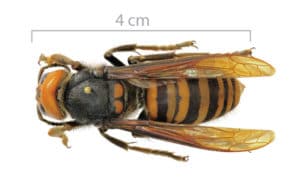
PHOTO: WASHINGTON STATE DEPARTMENT OF AGRICULTURE
The Washington State Department of Agriculture (WSDA) has trapped a male Asian giant hornet (Vespa mandarinia). Collected on July 29 and processed in WSDA’s entomology lab on Aug. 13, it is considered to be the first male Asian giant hornet — dubbed the “murder hornet” in popular culture — to be detected in the United States. Click here to watch the press conference about this detection.
According to a news release, the hornet was caught in a WSDA Asian giant hornet bottle trap near Custer, Wash., where a mated queen was found dead earlier this year and a suspected bee kill was reported in 2019.
“Trapping a male Asian giant hornet in July initially came as a surprise,” WSDA Managing Entomologist Sven Spichiger said in the news release. “But further examination of the research and consultation with international experts confirmed that a few males can indeed emerge early in the season.”
WSDA will be setting live traps in the area in an attempt to trap a live Asian giant hornet, tag it, and track it back to its nest. If WSDA is able to locate a nest, the agency will eradicate it.
This is the second Asian giant hornet caught in a WSDA trap. The first was caught July 14, and identified as an unmated queen. The two trapped specimens bring the total number of Asian giant hornets detected in Washington to seven. All of them have been captured in Whatcom County.
In addition to the traps that WSDA has set to catch Asian giant hornets, citizen scientists and other cooperators have placed more than 1,400 traps throughout the state. Traps require weekly bait replacement and a commitment to mail the trap contents to WSDA if bees or wasps are collected.
Because Asian giant hornet workers increase as a colony develops, they are most likely seen in August and September. If you think you have seen one, the WSDA asks that you report it at agr.wa.gov/hornets. Provide as much detail as you can about what you saw and where. Include a photo if you can safely obtain one. If you come across a dead specimen, keep it for potential testing.
Read more:

